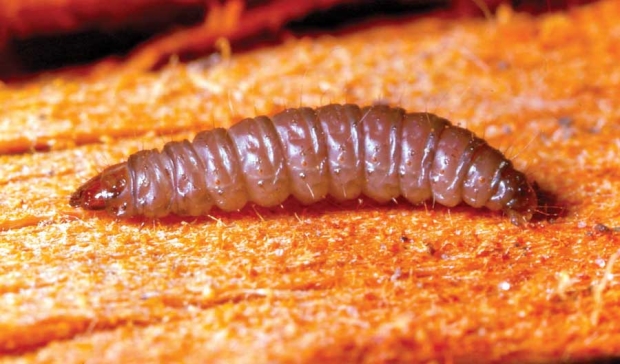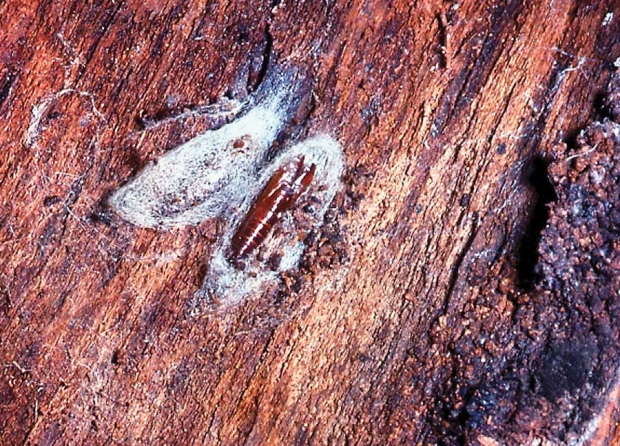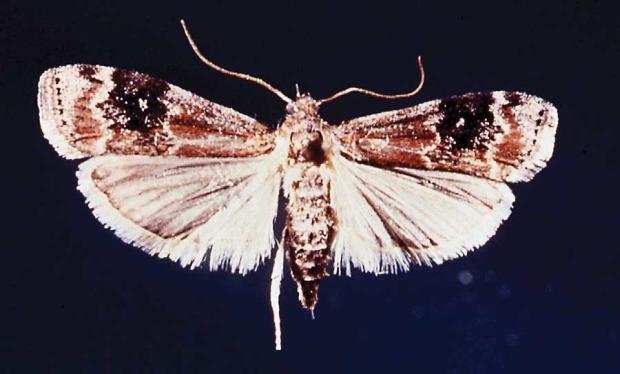
The American plum borer has been causing some damage to cherry trees in The Dalles, Ore., attracted to damage from the deep November 2014 freeze. The moth moth larvae have a unique purple-ish color. (Courtesy Dr. David Biddinger/Pennsylvania State University)
An opportunistic pest known to cause extensive damage in California and the eastern United States has arrived in Oregon’s cherry orchards in the wake of a harsh freeze during November 2014, and growers are advised to be on the lookout for it.
The American plum borer has been setting up shop in trees weakened by the historic cold snap that saw temperatures dip to minus 12°F in some places in Oregon’s Columbia River Gorge.
“I think it’s just going to be a pest to watch for,” said Drew Hubbard, a research and development specialist for G.S. Long in The Dalles, Oregon.
Hubbard and researchers call the plum borer, a moth whose larvae feed on the cambium under the bark, “opportunistic.” They are attracted to compromised trees, perhaps with injuries or places of soft tissue.

The American plum borer larvae over-winter in white, fuzzy cacoons under the bark. (Courtesy Dr. David Biddinger/Pennsylvania State University)
After the freeze, growers pruned way back to the leaders, sometimes to the trunks, to encourage their trees to start all over again building their structure. The “succulent” new growth attracted the borers, Hubbard said.
In early August last year, growers and field representatives noticed new shoots becoming frail and falling off trees.
They also found plum borer larvae and their frass, or droppings, and caught up to 20 adult moths per trap per week toward the end of that month in low-lying pockets where temperatures dipped the most.
Hubbard collected samples of the larvae and asked Dr. Peter Shearer, an entomologist with Oregon State University Mid-Columbia Agricultural Research and Extension Center in Hood River, to identify them. The plum borer, a native to North America, has little history in the Northwest, Shearer said.
“This insect is a major pest elsewhere (Michigan, California, New York) but has never been a big problem here,” Shearer said in an emailed statement. Local integrated pest management guides don’t mention it.
Growers and field representatives found small populations in 2010 after a lesser freeze, while Dr. Elizabeth Beers, an entomologist at Washington State University’s Tree Fruit Research and Extension Center in Wenatchee, spotted them attacking graft unions two recent years in Washington — in 2013 in Malaga and in August 2015 in East Wenatchee.

The American plum borer.(Courtesy Dr. David Biddinger/Pennsylvania State University)
However, Michigan has struggled with borer since the 1970s, said Dr. David Biddinger, an entomologist with Pennsylvania State University Fruit Research and Extension Center in Biglerville. He wrote his 1985 thesis on the moth after it had been “devastating” Michigan cherry trees for 12 years or so.
In a self-deprecating email, Biddinger describes himself as “probably the world’s expert on this pest, but that is not saying much outside of Michigan.” He blamed most of Michigan’s problems on the advent of mechanical harvesting of tart cherries.
The plum borer gets under the tree’s bark through wounds — in Michigan’s case, caused by the harvester’s clamps — to feed on the cambium just beneath.
“In mechanically harvested tart cherries in Michigan, we figure it reduced the life of an orchard by about one-third,” Biddinger said. “They can girdle a scaffold limb in only two to three seasons and an entire tree in five to seven years depending on the age of the trees when attacked and the pest pressure. (American plum borers) prevent wounds on fruit trees from healing and enlarge them so that diseases can enter for secondary infections.”
The borer has two generations per year in northern states, three in the South, Biddinger said. The overwintering larvae pupate in early spring and emerge as adults right before bloom. The second generation comes out just after harvest, attracted to the fresh harvester wounds.
“For you guys, I think it’s just going to be a nuisance,” Biddinger said. In the Northwest, sweet cherries are picked by hand, not machines.
Still, field representatives aren’t sure what to expect or what to do, though they advise pulling out dead trees and spot spraying with some registered chemicals, Hubbard said.
Growers in other states have used long-lasting insecticides at the site of wounds and crotches of young trees, Shearer said. Websites of Penn State and Cornell University in New York suggest timing treatments around petal fall. University of California-Davis pest management guidelines mention the use of Lorsban Advanced (chlorpyrifos), Diazinon 50W (diazinon) and Sevin 4F (carbaryl).
Observation will be job one, Hubbard said. “To a certain degree, it’s going to be a lot of monitoring this year to keep watching.” •
– by Ross Courtney






Leave A Comment